snow chains INFINITI Q50 2014 Owner's Manual
[x] Cancel search | Manufacturer: INFINITI, Model Year: 2014, Model line: Q50, Model: INFINITI Q50 2014Pages: 394, PDF Size: 1.99 MB
Page 181 of 394
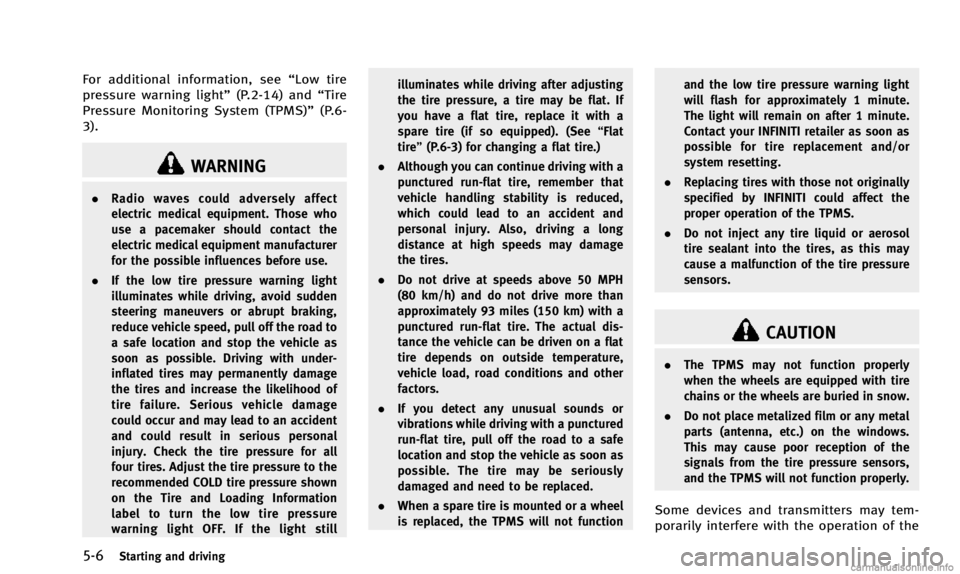
5-6Starting and driving
For additional information, see“Low tire
pressure warning light” (P.2-14) and“Tire
Pressure Monitoring System (TPMS) ”(P.6-
3).
WARNING
. Radio waves could adversely affect
electric medical equipment. Those who
use a pacemaker should contact the
electric medical equipment manufacturer
for the possible influences before use.
. If the low tire pressure warning light
illuminates while driving, avoid sudden
steering maneuvers or abrupt braking,
reduce vehicle speed, pull off the road to
a safe location and stop the vehicle as
soon as possible. Driving with under-
inflated tires may permanently damage
the tires and increase the likelihood of
tire failure. Serious vehicle damage
could occur and may lead to an accident
and could result in serious personal
injury. Check the tire pressure for all
four tires. Adjust the tire pressure to the
recommended COLD tire pressure shown
on the Tire and Loading Information
label to turn the low tire pressure
warning light OFF. If the light still illuminates while driving after adjusting
the tire pressure, a tire may be flat. If
you have a flat tire, replace it with a
spare tire (if so equipped). (See
“Flat
tire” (P.6-3) for changing a flat tire.)
. Although you can continue driving with a
punctured run-flat tire, remember that
vehicle handling stability is reduced,
which could lead to an accident and
personal injury. Also, driving a long
distance at high speeds may damage
the tires.
. Do not drive at speeds above 50 MPH
(80 km/h) and do not drive more than
approximately 93 miles (150 km) with a
punctured run-flat tire. The actual dis-
tance the vehicle can be driven on a flat
tire depends on outside temperature,
vehicle load, road conditions and other
factors.
. If you detect any unusual sounds or
vibrations while driving with a punctured
run-flat tire, pull off the road to a safe
location and stop the vehicle as soon as
possible. The tire may be seriously
damaged and need to be replaced.
. When a spare tire is mounted or a wheel
is replaced, the TPMS will not function and the low tire pressure warning light
will flash for approximately 1 minute.
The light will remain on after 1 minute.
Contact your INFINITI retailer as soon as
possible for tire replacement and/or
system resetting.
. Replacing tires with those not originally
specified by INFINITI could affect the
proper operation of the TPMS.
. Do not inject any tire liquid or aerosol
tire sealant into the tires, as this may
cause a malfunction of the tire pressure
sensors.
CAUTION
.The TPMS may not function properly
when the wheels are equipped with tire
chains or the wheels are buried in snow.
. Do not place metalized film or any metal
parts (antenna, etc.) on the windows.
This may cause poor reception of the
signals from the tire pressure sensors,
and the TPMS will not function properly.
Some devices and transmitters may tem-
porarily interfere with the operation of the
Page 201 of 394
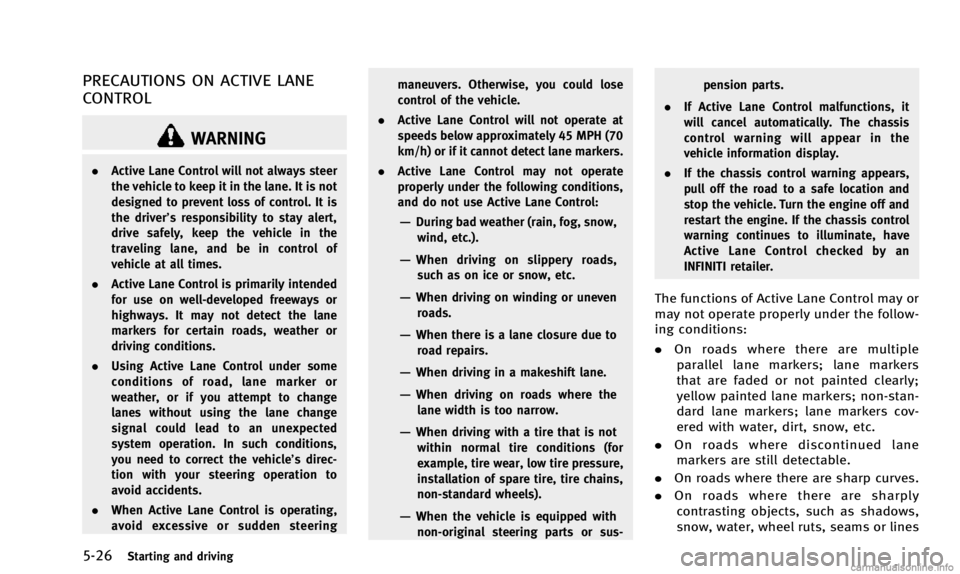
5-26Starting and driving
PRECAUTIONS ON ACTIVE LANE
CONTROL
WARNING
.Active Lane Control will not always steer
the vehicle to keep it in the lane. It is not
designed to prevent loss of control. It is
the driver’s responsibility to stay alert,
drive safely, keep the vehicle in the
traveling lane, and be in control of
vehicle at all times.
. Active Lane Control is primarily intended
for use on well-developed freeways or
highways. It may not detect the lane
markers for certain roads, weather or
driving conditions.
. Using Active Lane Control under some
conditions of road, lane marker or
weather, or if you attempt to change
lanes without using the lane change
signal could lead to an unexpected
system operation. In such conditions,
you need to correct the vehicle’s direc-
tion with your steering operation to
avoid accidents.
. When Active Lane Control is operating,
avoid excessive or sudden steering maneuvers. Otherwise, you could lose
control of the vehicle.
. Active Lane Control will not operate at
speeds below approximately 45 MPH (70
km/h) or if it cannot detect lane markers.
. Active Lane Control may not operate
properly under the following conditions,
and do not use Active Lane Control:
—During bad weather (rain, fog, snow,
wind, etc.).
—When driving on slippery roads,such as on ice or snow, etc.
—When driving on winding or uneven roads.
—When there is a lane closure due toroad repairs.
—When driving in a makeshift lane.
—When driving on roads where the
lane width is too narrow.
—When driving with a tire that is notwithin normal tire conditions (for
example, tire wear, low tire pressure,
installation of spare tire, tire chains,
non-standard wheels).
—When the vehicle is equipped withnon-original steering parts or sus- pension parts.
. If Active Lane Control malfunctions, it
will cancel automatically. The chassis
control warning will appear in the
vehicle information display.
. If the chassis control warning appears,
pull off the road to a safe location and
stop the vehicle. Turn the engine off and
restart the engine. If the chassis control
warning continues to illuminate, have
Active Lane Control checked by an
INFINITI retailer.
The functions of Active Lane Control may or
may not operate properly under the follow-
ing conditions:
.On roads where there are multiple
parallel lane markers; lane markers
that are faded or not painted clearly;
yellow painted lane markers; non-stan-
dard lane markers; lane markers cov-
ered with water, dirt, snow, etc.
. On roads where discontinued lane
markers are still detectable.
. On roads where there are sharp curves.
. On roads where there are sharply
contrasting objects, such as shadows,
snow, water, wheel ruts, seams or lines
Page 208 of 394
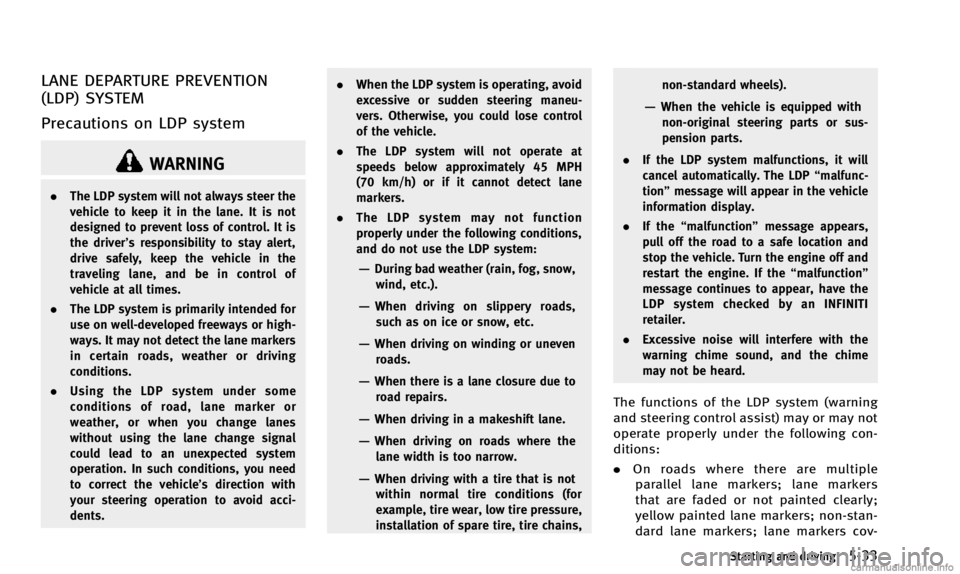
LANE DEPARTURE PREVENTION
(LDP) SYSTEM
Precautions on LDP system
WARNING
.The LDP system will not always steer the
vehicle to keep it in the lane. It is not
designed to prevent loss of control. It is
the driver’s responsibility to stay alert,
drive safely, keep the vehicle in the
traveling lane, and be in control of
vehicle at all times.
. The LDP system is primarily intended for
use on well-developed freeways or high-
ways. It may not detect the lane markers
in certain roads, weather or driving
conditions.
. Using the LDP system under some
conditions of road, lane marker or
weather, or when you change lanes
without using the lane change signal
could lead to an unexpected system
operation. In such conditions, you need
to correct the vehicle’s direction with
your steering operation to avoid acci-
dents. .
When the LDP system is operating, avoid
excessive or sudden steering maneu-
vers. Otherwise, you could lose control
of the vehicle.
. The LDP system will not operate at
speeds below approximately 45 MPH
(70 km/h) or if it cannot detect lane
markers.
. The LDP system may not function
properly under the following conditions,
and do not use the LDP system:
—During bad weather (rain, fog, snow,
wind, etc.).
—When driving on slippery roads,
such as on ice or snow, etc.
—When driving on winding or uneven roads.
—When there is a lane closure due to
road repairs.
—When driving in a makeshift lane.
—When driving on roads where thelane width is too narrow.
—When driving with a tire that is notwithin normal tire conditions (for
example, tire wear, low tire pressure,
installation of spare tire, tire chains, non-standard wheels).
—When the vehicle is equipped with
non-original steering parts or sus-
pension parts.
. If the LDP system malfunctions, it will
cancel automatically. The LDP “malfunc-
tion” message will appear in the vehicle
information display.
. If the “malfunction” message appears,
pull off the road to a safe location and
stop the vehicle. Turn the engine off and
restart the engine. If the “malfunction”
message continues to appear, have the
LDP system checked by an INFINITI
retailer.
. Excessive noise will interfere with the
warning chime sound, and the chime
may not be heard.
The functions of the LDP system (warning
and steering control assist) may or may not
operate properly under the following con-
ditions:
.On roads where there are multiple
parallel lane markers; lane markers
that are faded or not painted clearly;
yellow painted lane markers; non-stan-
dard lane markers; lane markers cov-
Starting and driving5-33
Page 216 of 394
![INFINITI Q50 2014 Owners Manual The BSI system turns on when the dynamic
driver assistance switch on the steering
wheel is pushed when the [Blind Spot
Intervention] is enabled in the settings
menu on the lower display. The driver
as INFINITI Q50 2014 Owners Manual The BSI system turns on when the dynamic
driver assistance switch on the steering
wheel is pushed when the [Blind Spot
Intervention] is enabled in the settings
menu on the lower display. The driver
as](/img/42/34965/w960_34965-215.png)
The BSI system turns on when the dynamic
driver assistance switch on the steering
wheel is pushed when the [Blind Spot
Intervention] is enabled in the settings
menu on the lower display. The driver
assist system blind spot indicator (green)
in the vehicle information display illumi-
nates when the BSI system is turned on.
The BSI system provides an audible warn-
ing and flashes the side indicator light
when BSI is activated even if the BSW
system is off.
JVS0246X
How to enable/disable the BSI system:
Perform the following steps to enable or
disable the BSI system.
1. Push the MENU button
*1and touch
[Driver Assistance] on the lower dis-
play.
2. Touch [Blind Spot Assist].
3. Touch [Blind Spot Intervention] to enable or disable the system.
WARNING
. Do not use the BSI system under the
following conditions because the system may not function properly.
—During bad weather (for example,
rain, fog, snow, wind, etc.)
—When driving on slippery roads,such as on ice or snow, etc.
—When driving on winding or uneven
roads.
—When there is a lane closure due toroad repairs.
—When driving in a makeshift lane.
—When driving on roads where thelane width is too narrow.
—When driving with a tire that is notwithin normal tire conditions (for
example, tire wear, low tire pressure,
installation of spare tire, tire chains,
non-standard wheels).
—When the vehicle is equipped with
non-original steering parts or sus-
pension parts.
. Excessive noise (for example, audio
system volume, open vehicle window)
will interfere with the chime sound, and
it may not be heard.
Starting and driving5-41
Page 282 of 394
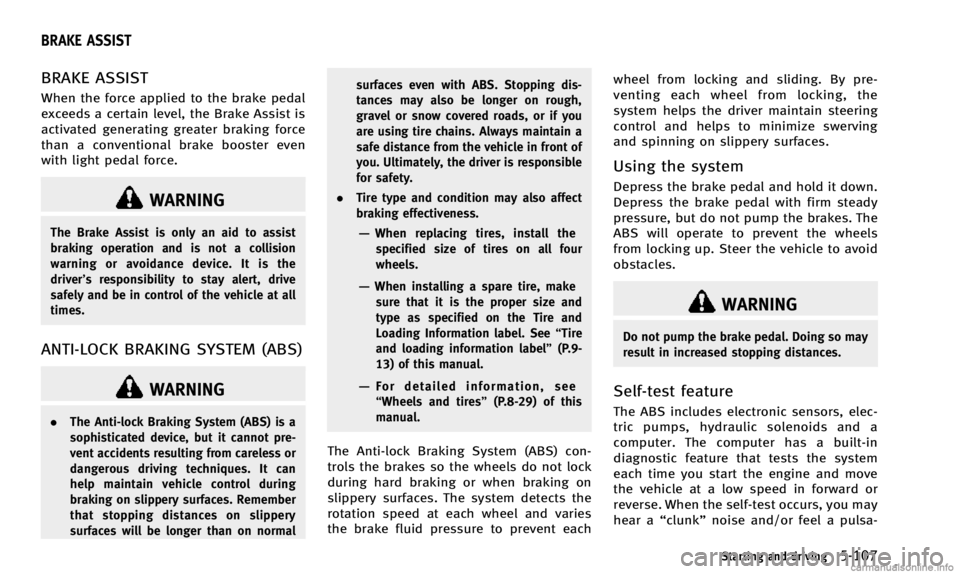
BRAKE ASSIST
When the force applied to the brake pedal
exceeds a certain level, the Brake Assist is
activated generating greater braking force
than a conventional brake booster even
with light pedal force.
WARNING
The Brake Assist is only an aid to assist
braking operation and is not a collision
warning or avoidance device. It is the
driver’s responsibility to stay alert, drive
safely and be in control of the vehicle at all
times.
ANTI-LOCK BRAKING SYSTEM (ABS)
WARNING
.The Anti-lock Braking System (ABS) is a
sophisticated device, but it cannot pre-
vent accidents resulting from careless or
dangerous driving techniques. It can
help maintain vehicle control during
braking on slippery surfaces. Remember
that stopping distances on slippery
surfaces will be longer than on normal surfaces even with ABS. Stopping dis-
tances may also be longer on rough,
gravel or snow covered roads, or if you
are using tire chains. Always maintain a
safe distance from the vehicle in front of
you. Ultimately, the driver is responsible
for safety.
. Tire type and condition may also affect
braking effectiveness.
—When replacing tires, install the
specified size of tires on all four
wheels.
—When installing a spare tire, make sure that it is the proper size and
type as specified on the Tire and
Loading Information label. See “Tire
and loading information label” (P.9-
13) of this manual.
—For detailed information, see “Wheels and tires” (P.8-29) of this
manual.
The Anti-lock Braking System (ABS) con-
trols the brakes so the wheels do not lock
during hard braking or when braking on
slippery surfaces. The system detects the
rotation speed at each wheel and varies
the brake fluid pressure to prevent each wheel from locking and sliding. By pre-
venting each wheel from locking, the
system helps the driver maintain steering
control and helps to minimize swerving
and spinning on slippery surfaces.
Using the system
Depress the brake pedal and hold it down.
Depress the brake pedal with firm steady
pressure, but do not pump the brakes. The
ABS will operate to prevent the wheels
from locking up. Steer the vehicle to avoid
obstacles.
WARNING
Do not pump the brake pedal. Doing so may
result in increased stopping distances.
Self-test feature
The ABS includes electronic sensors, elec-
tric pumps, hydraulic solenoids and a
computer. The computer has a built-in
diagnostic feature that tests the system
each time you start the engine and move
the vehicle at a low speed in forward or
reverse. When the self-test occurs, you may
hear a
“clunk” noise and/or feel a pulsa-
Starting and driving5-107
BRAKE ASSIST
Page 284 of 394
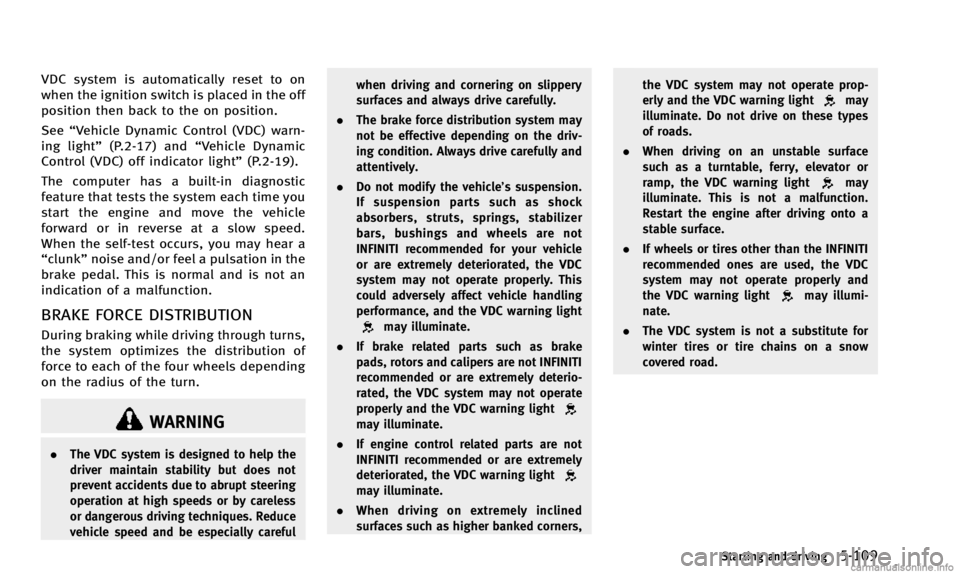
VDC system is automatically reset to on
when the ignition switch is placed in the off
position then back to the on position.
See“Vehicle Dynamic Control (VDC) warn-
ing light” (P.2-17) and “Vehicle Dynamic
Control (VDC) off indicator light” (P.2-19).
The computer has a built-in diagnostic
feature that tests the system each time you
start the engine and move the vehicle
forward or in reverse at a slow speed.
When the self-test occurs, you may hear a
“clunk” noise and/or feel a pulsation in the
brake pedal. This is normal and is not an
indication of a malfunction.
BRAKE FORCE DISTRIBUTION
During braking while driving through turns,
the system optimizes the distribution of
force to each of the four wheels depending
on the radius of the turn.
WARNING
. The VDC system is designed to help the
driver maintain stability but does not
prevent accidents due to abrupt steering
operation at high speeds or by careless
or dangerous driving techniques. Reduce
vehicle speed and be especially careful when driving and cornering on slippery
surfaces and always drive carefully.
. The brake force distribution system may
not be effective depending on the driv-
ing condition. Always drive carefully and
attentively.
. Do not modify the vehicle’s suspension.
If suspension parts such as shock
absorbers, struts, springs, stabilizer
bars, bushings and wheels are not
INFINITI recommended for your vehicle
or are extremely deteriorated, the VDC
system may not operate properly. This
could adversely affect vehicle handling
performance, and the VDC warning light
may illuminate.
. If brake related parts such as brake
pads, rotors and calipers are not INFINITI
recommended or are extremely deterio-
rated, the VDC system may not operate
properly and the VDC warning light
may illuminate.
. If engine control related parts are not
INFINITI recommended or are extremely
deteriorated, the VDC warning light
may illuminate.
. When driving on extremely inclined
surfaces such as higher banked corners, the VDC system may not operate prop-
erly and the VDC warning light
may
illuminate. Do not drive on these types
of roads.
. When driving on an unstable surface
such as a turntable, ferry, elevator or
ramp, the VDC warning light
may
illuminate. This is not a malfunction.
Restart the engine after driving onto a
stable surface.
. If wheels or tires other than the INFINITI
recommended ones are used, the VDC
system may not operate properly and
the VDC warning light
may illumi-
nate.
. The VDC system is not a substitute for
winter tires or tire chains on a snow
covered road.
Starting and driving5-109
Page 287 of 394

5-112Starting and driving
The chassis control is an electric control
module that includes the following func-
tions:
.Log-in function (See “Log-in function”
(P.3-14).)
. INFINITI Drive Mode Selector (See
“ INFINITI Drive Mode Selector” (P.5-
21).)
. Active Lane Control (if so equipped)
(See “Active Lane Control” (P.5-24).)
. Active Trace Control (See “Active trace
control” (P.5-110).)FREEING A FROZEN DOOR LOCK
To prevent a door lock from freezing, apply
deicer through the key hole. If the lock
becomes frozen, heat the key before
inserting it into the key hole or use the
Intelligent Key system.
ANTIFREEZE
In the winter when it is anticipated that the
outside temperature will drop below 32 8F
(08C), check antifreeze to assure proper
winter protection. For additional informa-
tion, see “Engine cooling system” (P.8-8).
BATTERY
If the battery is not fully charged during
extremely cold weather conditions, the
battery fluid may freeze and damage the
battery. To maintain maximum efficiency,
the battery should be checked regularly.
For additional information, see “Battery”
(P.8-15).
DRAINING OF COOLANT WATER
If the vehicle is to be left outside without
antifreeze, drain the cooling system, in-
cluding the engine block. Refill before
operating the vehicle. For details, see
“Engine cooling system” (P.8-8).
TIRE EQUIPMENT
SUMMER tires have a tread designed to
provide superior performance on dry pave-
ment. However, the performance of these
tires will be substantially reduced in snowy
and icy conditions. If you operate your
vehicle on snowy or icy roads, INFINITI
recommends the use of MUD & SNOW or
ALL SEASON tires on all four wheels.
Consult an INFINITI retailer for the tire
type, size, speed rating and availability
information.
For additional traction on icy roads,
studded tires may be used. However, some
U.S. states and Canadian provinces prohi-
bit their use. Check local, state and
provincial laws before installing studded
tires.
Skid and traction capabilities of studded
snow tires, on wet or dry surfaces, may be
poorer than that of non-studded snow
tires.
Tire chains may be used. For details, see
“Tire chains”(P.8-37) of this manual.
Intelligent All-Wheel Drive (AWD)
models
If you install snow tires, they must also be
the same size, brand, construction and
CHASSIS CONTROL COLD WEATHER DRIVING
Page 307 of 394
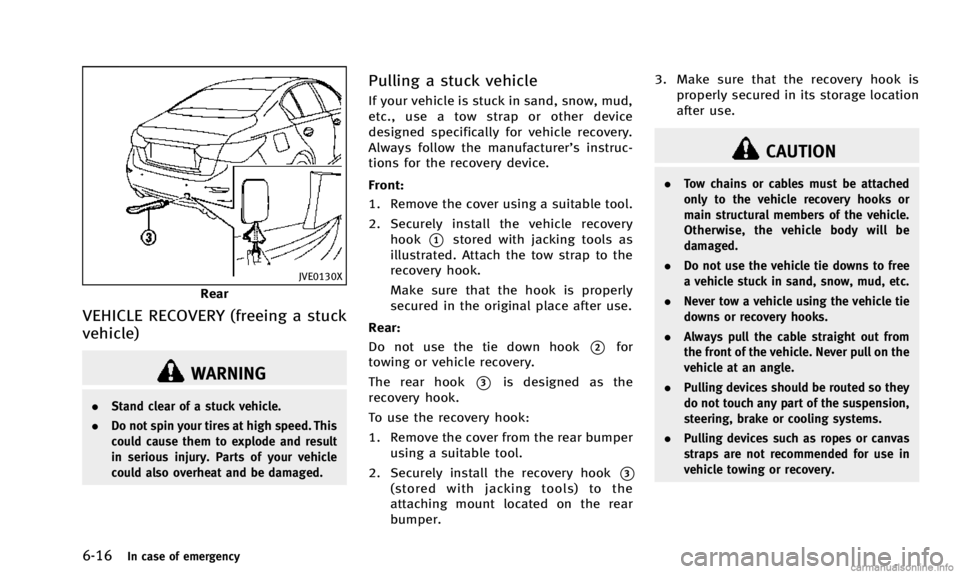
6-16In case of emergency
JVE0130X
Rear
VEHICLE RECOVERY (freeing a stuck
vehicle)
WARNING
.Stand clear of a stuck vehicle.
. Do not spin your tires at high speed. This
could cause them to explode and result
in serious injury. Parts of your vehicle
could also overheat and be damaged.
Pulling a stuck vehicle
If your vehicle is stuck in sand, snow, mud,
etc., use a tow strap or other device
designed specifically for vehicle recovery.
Always follow the manufacturer’s instruc-
tions for the recovery device.
Front:
1. Remove the cover using a suitable tool.
2. Securely install the vehicle recovery hook
*1stored with jacking tools as
illustrated. Attach the tow strap to the
recovery hook.
Make sure that the hook is properly
secured in the original place after use.
Rear:
Do not use the tie down hook
*2for
towing or vehicle recovery.
The rear hook
*3is designed as the
recovery hook.
To use the recovery hook:
1. Remove the cover from the rear bumper
using a suitable tool.
2. Securely install the recovery hook
*3(stored with jacking tools) to the
attaching mount located on the rear
bumper. 3. Make sure that the recovery hook is
properly secured in its storage location
after use.
CAUTION
. Tow chains or cables must be attached
only to the vehicle recovery hooks or
main structural members of the vehicle.
Otherwise, the vehicle body will be
damaged.
. Do not use the vehicle tie downs to free
a vehicle stuck in sand, snow, mud, etc.
. Never tow a vehicle using the vehicle tie
downs or recovery hooks.
. Always pull the cable straight out from
the front of the vehicle. Never pull on the
vehicle at an angle.
. Pulling devices should be routed so they
do not touch any part of the suspension,
steering, brake or cooling systems.
. Pulling devices such as ropes or canvas
straps are not recommended for use in
vehicle towing or recovery.
Page 358 of 394
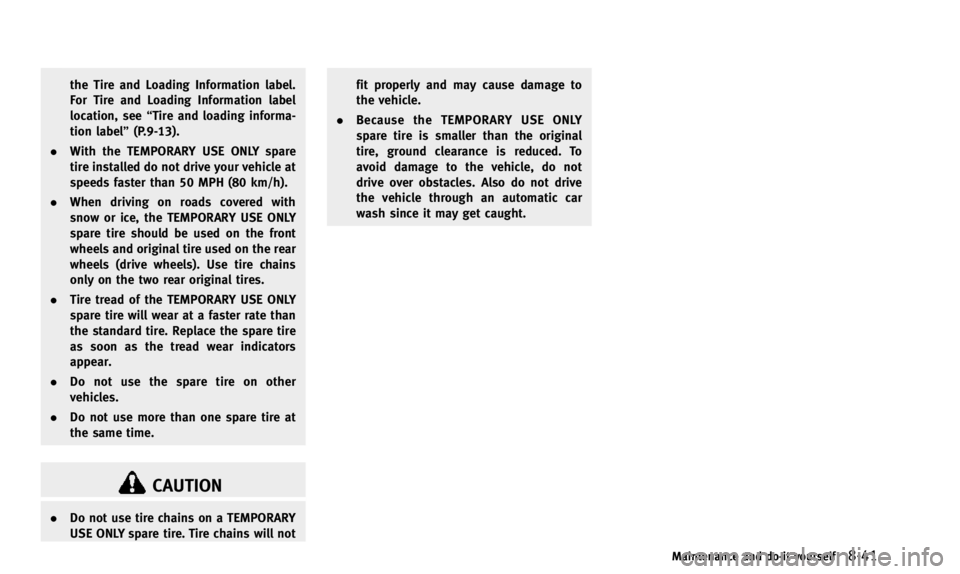
the Tire and Loading Information label.
For Tire and Loading Information label
location, see“Tire and loading informa-
tion label” (P.9-13).
. With the TEMPORARY USE ONLY spare
tire installed do not drive your vehicle at
speeds faster than 50 MPH (80 km/h).
. When driving on roads covered with
snow or ice, the TEMPORARY USE ONLY
spare tire should be used on the front
wheels and original tire used on the rear
wheels (drive wheels). Use tire chains
only on the two rear original tires.
. Tire tread of the TEMPORARY USE ONLY
spare tire will wear at a faster rate than
the standard tire. Replace the spare tire
as soon as the tread wear indicators
appear.
. Do not use the spare tire on other
vehicles.
. Do not use more than one spare tire at
the same time.
CAUTION
.Do not use tire chains on a TEMPORARY
USE ONLY spare tire. Tire chains will not fit properly and may cause damage to
the vehicle.
. Because the TEMPORARY USE ONLY
spare tire is smaller than the original
tire, ground clearance is reduced. To
avoid damage to the vehicle, do not
drive over obstacles. Also do not drive
the vehicle through an automatic car
wash since it may get caught.
Maintenance and do-it-yourself8-41
Page 389 of 394

10-6
Three-point type .......................................... 1-15
Seat(s) Driver-side memory ...................................... 3-29
Heated seats ................................................. 1-5
Seats ............................................................. 1-2
Security system Vehicle security system ................................ 2-31
Security system (INFINITI Vehicle Immobilizer
System) Engine start ................................................. 2-32
Shift lever Shift lock release ......................................... 5-18
Shift lock release, Transmission ........................ 5-18
Shifting Automatic transmission ............................... 5-15
Shoulder belt height adjustment ....................... 1-20
SNOW mode ..................................................... 5-22
Spare tire ........................................................... 9-9
Spark plugs ...................................................... 8-18
Speedometer ...................................................... 2-7
SPORT mode ..................................................... 5-22
STANDARD mode ............................................... 5-21
Starting
Before starting the engine ........................... 5-13
Jump starting ............................................... 8-16
Precautions when starting and driving ........... 5-3
Push starting ............................................... 6-11
Starting the engine ...................................... 5-14
Status light, Front passenger air bag ................ 1-49
Steering Direct Adaptive Steering ............................ 5-104 Power steering fluid ..................................... 8-13
Power steering system ............................... 5-104
Tilt/telescopic steering ................................. 3-24
Storage ............................................................. 2-45
Storage box ...................................................... 2-48
Sun visors ........................................................ 3-25
Sunglasses holder ............................................ 2-46
Supplemental air bag warning labels ................ 1-55
Supplemental air bag warning light ......... 1-55, 2-16
Supplemental restraint system .......................... 1-42
Precautions on supplemental
restraint system ........................................... 1-42
Switch
Autolight switch ........................................... 2-37
Fog light switch ........................................... 2-42
Hazard warning flasher switch ....................... 6-2
Headlight switch .......................................... 2-36
Ignition switch ............................................. 5-15
Power door lock switch .................................. 3-5
Rear window and outside mirror
defroster switch ........................................... 2-36
Turn signal switch ........................................ 2-42
Vehicle Dynamic Control (VDC) off switch ..... 2-43
T
Tachometer ......................................................... 2-8
Temperature gauge
Engine coolant temperature gauge ................. 2-8
Theft (INFINITI Vehicle Immobilizer System) Engine start ................................................. 2-32
Thigh extension .................................................. 1-5 Three-way catalyst .............................................. 5-4
Tilt/telescopic steering ...................................... 3-24
Tire
Flat Tire - Visit dealer warning ..................... 2-23
Run-flat tires .................................................. 6-4
Tire replacement indicator ............................ 2-26
Tire rotation ................................................. 8-38
Tire pressure Low tire pressure warning light .................... 2-14
Tire Pressure Low - Add Air warning .................. 2-23
Tires Flat tire .......................................................... 6-3
Low tire pressure warning system ... 5-4, 6-3, 8-29
Run-flat tires ................................................ 8-36
Spare tire .................................................... 8-40
Tire and Loading information label ...... 8-31, 9-13
Tire chains ................................................... 8-37
Tire dressing .................................................. 7-4
Tire pressure................................................ 8-29
Tire Pressure Monitoring
System (TPMS) .............................. 5-4, 6-3, 8-29
Types of tires ............................................... 8-35
Uniform tire quality grading ......................... 9-19
Wheel/tire size .............................................. 9-9
Wheels and tires .......................................... 8-29
Towing Flat towing ................................................... 9-19
Tow truck towing .......................................... 6-13
Towing a trailer ............................................ 9-19
TPMS Tire Pressure Monitoring System ... 5-4, 6-3, 8-29